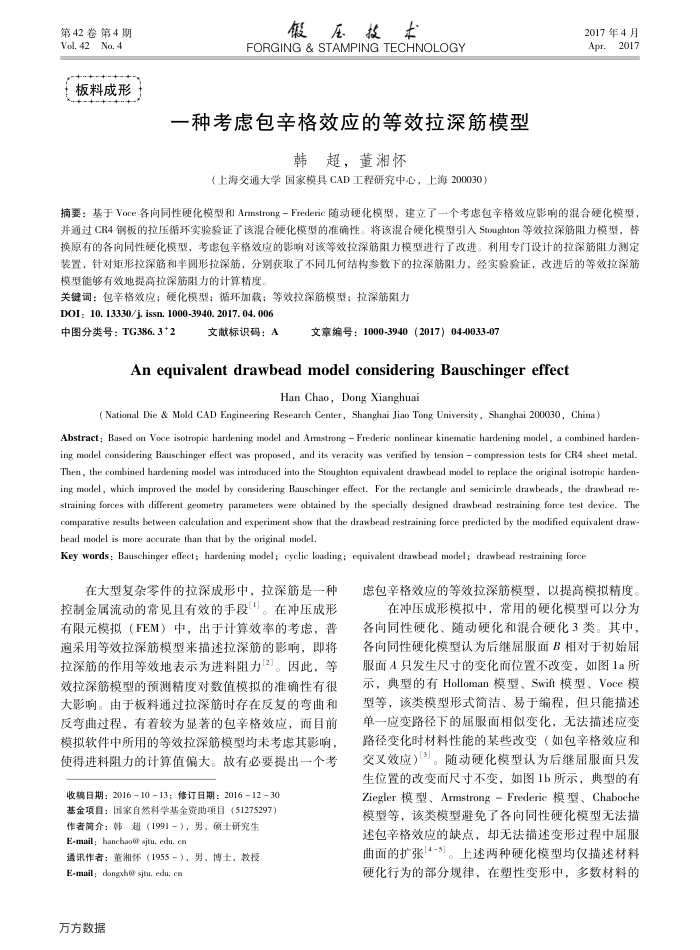您当前的位置:首页>论文资料>一种考虑包辛格效应的等效拉深筋模型
内容简介
 第42卷第4期 Vol.42No.4
第42卷第4期 Vol.42No.4板料成形
假压技术
FORGING & STAMPING TECHNOLOGY
一种考虑包辛格效应的等效拉深筋模型
韩超,董湘怀
(上海交通大学国家模具CAD工程研究中心,上海200030)
2017年4月 Apr.2017
摘要:基于Voce各向同性硬化模型和Armstrong-Frederic随动硬化模型,建立了一个考患包辛格效应影响的混合硬化模型,并通过CR4钢板的拉压循环实验验证了该混合硬化模型的准确性。将该混合硬化模型引人Stoughton等效拉深筋阻力模型,替换原有的各向同性硬化模型,考虑包辛格效应的影响对该等效拉深筋阻力模型进行了改进。利用专门设计的拉深筋阻力测定“ 模型能够有效地提高拉深筋阻力的计算精度,
关键词:包辛格效应;硬化模型;循环加载;等效拉深筋模型:拉深筋阻力 DOI: 10. 13330/j. issn. 1000-3940. 2017. 04. 006
中图分类号:TG386.3*2
文献标识码:A
文章编号:1000-3940(2017)04-0033-07
An equivalent drawbead model considering Bauschinger effect
Han Chao,Dong Xianghuai
( National Die & Mold CAD Engineering Research Center, Shanghai Jiao Tong University, Shanghai 200030, China)
Abstract: Based on Voce isotropic: hardening model and Amstrong Frederic nonlinear kinematic hardening model, a combined harden ing model considering Bauschinger effect was proposed, and its veracity was verified by tension compression tests for CR4 sheet metal Then , the combined hardening model was introduced into the Stoughton equivalent drawbead model to replace the original isotropic harden-ing model, which improved the model by considering Bauschinger effect. For the rectangle and semicircle drawbeads, the drawbead re-straining forces with different geometry parameters were obtained by the specially designed drawbead restraining force test device. The comparative results between calculation and experiment show that the drawbead restraining force predicted by the modified equivalent draw-bead model is more accurate than that by the original model.
Key words : Bauschinger effect; hardening model; cyclie loading; equivalent drawbead model; drawbead restraining foree
在大型复杂零件的拉深成形中,拉深筋是一种控制金属流动的常见且有效的手段"。在冲压成形有限元模拟(FEM)中,出于计算效率的考虑,普遍采用等效拉深筋模型来描述拉深筋的影响,即将拉深筋的作用等效地表示为进料阻力2]。因此,等效拉深筋模型的预测精度对数值模拟的准确性有很大影响。由于板料通过拉深筋时存在反复的弯曲和反弯曲过程,有着较为显著的包辛格效应,而目前模拟软件中所用的等效拉深筋模型均未考虑其影响,使得进料阻力的计算值偏大。故有必要提出一个考
收稿日期:201610-13;修订日期:20161230 基金项目:国家自然科学基金资助项目(51275297)
作者简介:韩超(1991-),男,硕士研究生 E-mail: hanchao@ sjtu. edu. cn
通讯作者:董湘怀(1955-),男,博士,教授
E-mail: dongxh@ sjtu. edu. ce 万方数据
虑包辛格效应的等效拉深筋模型,以提高模拟精度,
在冲压成形模拟中,常用的硬化模型可以分为各向同性硬化、随动硬化和混合硬化3类。其中,各向同性硬化模型认为后继届服面B相对于初始届服面A只发生尺寸的变化而位置不改变,如图1a所示,典型的有Holloman模型、Swift模型、Voce模型等,该类模型形式简洁、易于编程,但只能描述单一应变路径下的届服面相似变化,无法描述应变路径变化时材料性能的某些改变(如包辛格效应和交叉效应)3。随动硬化模型认为后继届服面只发生位置的改变而尺寸不变,如图1b所示,典型的有 Ziegler模型、Armstrong-Frederic模型、Chaboche 模型等,该类模型避免了各向同性硬化模型无法描述包辛格效应的缺点,却无法描述变形过程中届服曲面的扩张[4-5]。上述两种硬化模型均仅描述材料硬化行为的部分规律,在塑性变形中,多数材料的
上一章:汽车纵梁冲压成形数值模拟及试验验证
下一章:热轧高强钢冷却板形控制技术的应用